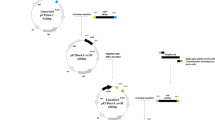Abstract
Novel synthetic isoprenoids have been synthesized in engineered microbial hosts by evolving terpene synthase or expressing heterologous terpene synthases. Recently, the native operon, crtNaNcM derived from Planococcus sp. PAMC 21323, has isolated for potential industrial applications of C35 carotenoids. For the first time, novel C35 carotenoids (sesquarterpene) were synthesized in Corynebacterium glutamicum expressing the crtNaNcM genes. The recombinant strains accumulate various sesquarterpene including 4-apolycopene (red color), 4-aponeurosporene (yellow color), and no pigmentation, depending on the expression of the genetic elements of the crtNaNcM genes. Subsequently, the carotenoid extract from the cells harboring pCES-H36-CrtNaNcM was analyzed, resulting in significantly higher antioxidant activity than those of other strains harboring pCES-H36-CrtNcM and pCES-H36-CrtNaNc, respectively. This study will promote further engineering of C. glutamicum to increase sesquarterpene productions.




Similar content being viewed by others
References
Netzer, R., Stafsnes, M. H., Andreassen, T., Goksoyr, A., Bruheim, P., & Brautaset, T. (2010). Biosynthetic pathway for gamma-cyclic sarcinaxanthin in Micrococcus luteus: heterologous expression and evidence for diverse and multiple catalytic functions of C(50) carotenoid cyclases. Journal of Bacteriology, 192(21), 5688–5699.
Tobias, A. V., & Arnold, F. H. (2006). Biosynthesis of novel carotenoid families based on unnatural carbon backbones: a model for diversification of natural product pathways. Biochimica et Biophysica Acta, 1761(2), 235–246.
Umeno, D., Tobias, A. V., & Arnold, F. H. (2005). Diversifying carotenoid biosynthetic pathways by directed evolution. Microbiology and Molecular Biology Reviews, 69(1), 51–78.
Albrecht, M., Takaichi, S., Steiger, S., Wang, Z. Y., & Sandmann, G. (2000). Novel hydroxycarotenoids with improved antioxidative properties produced by gene combination in Escherichia coli. Nature Biotechnology, 18(8), 843–846.
Osawa, A., Ishii, Y., Sasamura, N., Morita, M., Kasai, H., Maoka, T., & Shindo, K. (2010). Characterization and antioxidative activities of rare C(50) carotenoids-sarcinaxanthin, sarcinaxanthin monoglucoside, and sarcinaxanthin diglucoside-obtained from Micrococcus yunnanensis. Journal of Oleo Science, 59(12), 653–659.
Lee, P. C., & Schmidt-Dannert, C. (2002). Metabolic engineering towards biotechnological production of carotenoids in microorganisms. Applied Microbiology and Biotechnology, 60(1-2), 1–11.
Shindo, K., Endo, M., Miyake, Y., Wakasugi, K., Morritt, D., Bramley, P. M., Fraser, P. D., Kasai, H., & Misawa, N. (2014). Methyl 5-glucosyl-5,6-dihydro-apo-4,4′-lycopenoate, a novel antioxidative glyco-C30-carotenoic acid produced by a marine bacterium Planococcus maritimus. Journal of Antibiotics, 67(10), 731–732.
Umeno, D., & Arnold, F. H. (2003). A C35 carotenoid biosynthetic pathway. Applied and Environmental Microbiology, 69(6), 3573–3579.
Heider, S. A. E., Peters-Wendisch, P., & Wendisch, V. F. (2012). Carotenoid biosynthesis and overproduction in Corynebacterium glutamicum. BMC Microbiology, 12(1), 198.
Krubasik, P., Takaichi, S., Maoka, T., Kobayashi, M., Masamoto, K., & Sandmann, G. (2001). Detailed biosynthetic pathway to decaprenoxanthin diglucoside in Corynebacterium glutamicum and identification of novel intermediates. Archives of Microbiology, 176(3), 217–223.
Kang, M. K., Eom, J. H., Kim, Y., Um, Y., & Woo, H. M. (2014). Biosynthesis of pinene from glucose using metabolically-engineered Corynebacterium glutamicum. Biotechnology Letters, 36(10), 2069–2077.
Heider, S. A. E., Wolf, N., Hofemeier, A., Peters-Wendisch, P., & Wendisch, V. F. (2014). Optimization of the IPP precursor supply for the production of lycopene, decaprenoxanthin and astaxanthin by Corynebacterium glutamicum. Frontiers in Bioengineering and Biotechnology, 2. https://doi.org/10.3389/fbioe.2014.00028
Woo, H. M., & Park, J. B. (2014). Recent progress in development of synthetic biology platforms and metabolic engineering of Corynebacterium glutamicum. Journal of Biotechnology, 180, 43–51.
Yim, S. S., An, S. J., Kang, M., Lee, J., & Jeong, K. J. (2013). Isolation of fully synthetic promoters for high-level gene expression in Corynebacterium glutamicum. Biotechnology and Bioengineering, 110(11), 2959–2969.
Kim, C.-H., Park, M.-K., Kim, S.-K., & Cho, Y.-H. (2014). Antioxidant capacity and anti-inflammatory activity of lycopene in watermelon. International Journal of Food Science & Technology, 49(9), 2083–2091.
Sharma, O. P., & Bhat, T. K. (2009). DPPH antioxidant assay revisited. Food Chemistry, 113(4), 1202–1205.
Steiger, S., Sandmann, G., Fraser, P. D., Perez-Fons, L., & Cutting, S. M. (2015). Annotation and functional assignment of the genes for the C30 carotenoid pathways from the genomes of two bacteria: Bacillus indicus and Bacillus firmus. Microbiology, 161(1), 194–202.
Raisig, A., & Sandmann, G. (2001). Functional properties of diapophytoene and related desaturases of C(30) and C(40) carotenoid biosynthetic pathways. Biochimica et Biophysica Acta, 1533(2), 164–170.
Takaichi, S. (2000). Characterization of carotenes in a combination of a C(18) HPLC column with isocratic elution and absorption spectra with a photodiode-array detector. Photosynthesis Research, 65(1), 93–99.
Takaichi, S., Inoue, K., Akaike, M., Kobayashi, M., Oh-oka, H., & Madigan, M. T. (1997). The major carotenoid in all known species of heliobacteria is the C30 carotenoid 4,4′-diaponeurosporene, not neurosporene. Archives of Microbiology, 168(4), 277–281.
Köcher, S., Breitenbach, J., Müller, V., & Sandmann, G. (2008). Structure, function and biosynthesis of carotenoids in the moderately halophilic bacterium Halobacillus halophilus. Archives of Microbiology, 191, 95–104.
Sharoni, Y., Linnewiel-Hermoni, K., Khanin, M., Salman, H., Veprik, A., Danilenko, M., & Levy, J. (2012). Carotenoids and apocarotenoids in cellular signaling related to cancer: a review. Molecular Nutrition & Food Research, 56(2), 259–269.
Firn, R. D., & Jones, C. G. (2000). The evolution of secondary metabolism—a unifying model. Molecular Microbiology, 37(5), 989–994.
Kim, S. H., Kim, J. H., Lee, B. Y., & Lee, P. C. (2014). The astaxanthin dideoxyglycoside biosynthesis pathway in Sphingomonas sp. PB304. Applied Microbiology and Biotechnology, 98(24), 9993–10003.
Lee, P. C., Salomon, C., Mijts, B., & Schmidt-Dannert, C. (2008). Biosynthesis of ubiquinone compounds with conjugated prenyl side chains. Applied and Environmental Microbiology, 74(22), 6908–6917.
Acknowledgements
The authors would liketo thank Dr. Ki Jun Jeong at KAIST for providing a pCES-H36-GFP vector.
Funding
This study was financially supported by the National Research Foundation of Korea (NRF) grant funded by the Korea government (MSIP) (No.NRF-2015R1A2A2A01004733), by Golden Seed Project (213008-05-2-SB910), Ministry of Agriculture, Ministry of Oceans and Fisheries.
Author information
Authors and Affiliations
Corresponding author
Ethics declarations
Conflict of Interest
The authors declare that they have no conflict of interest.
Rights and permissions
About this article
Cite this article
Ravikumar, S., Woo, H.M. & Choi, Ji. Analysis of Novel Antioxidant Sesquarterpenes (C35 Terpenes) Produced in Recombinant Corynebacterium glutamicum. Appl Biochem Biotechnol 186, 525–534 (2018). https://doi.org/10.1007/s12010-018-2756-9
Received:
Accepted:
Published:
Issue Date:
DOI: https://doi.org/10.1007/s12010-018-2756-9




